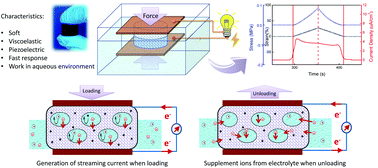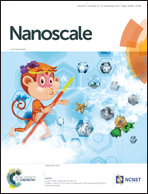Self-powered hydrogels induced by ion transport†
Abstract
Electroactive hydrogels are needed to enable stretchable electronics because of their flexible mechanical characteristics and electrical conductive properties. We describe a class of viscoelastic, porous, ion-conductive, and self-powered hydrogels that are fabricated based on a PHEMA hydrogel (poly(2-hydroxyethyl methacrylate)) and PPy (polypyrrole). They are capable of creating synchronous ionic current in electrolyte solution when enduring mechanical deformation. The conditions that impact the electric response of the hydrogel, such as stress, strain rate, pH of electrolyte solution, and concentration of ions in the electrolyte solution, have been investigated and reported in this paper. The mechanism of creating ionic current under deformation is elaborated through numerical simulation and experimental tests. Moreover, by embedding the electrically self-powered hydrogel into a movable object, such as a sports shoe, the patterns of mechanical actions (e.g. walking, running, or jumping) can be identified from the generated electrical current without any assistance of external batteries or power sources. It presents the outstanding potential of this hydrogel in building self-powered soft devices including active sensors and artificial skins.



 Please wait while we load your content...
Please wait while we load your content...